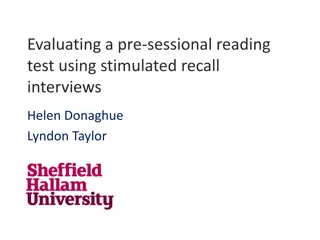Test
The Navier-Stokes equation and other fluid dynamics concepts are explored in this content. Topics covered include turbulent viscosity, Euler equation, continuity equation, turbulence behavior, Reynolds equations, and boundary conditions. The relationship between unknowns, properties of flow, and relevant equations are discussed in detail.
Download Presentation

Please find below an Image/Link to download the presentation.
The content on the website is provided AS IS for your information and personal use only. It may not be sold, licensed, or shared on other websites without obtaining consent from the author.If you encounter any issues during the download, it is possible that the publisher has removed the file from their server.
You are allowed to download the files provided on this website for personal or commercial use, subject to the condition that they are used lawfully. All files are the property of their respective owners.
The content on the website is provided AS IS for your information and personal use only. It may not be sold, licensed, or shared on other websites without obtaining consent from the author.
E N D
Presentation Transcript
In the Navier-Stokes equation for an incompressible fluid the following unknowns are present 3 velocity components only pressure and 3 velocity components pressure, density and 3 velocity components pressure and density only
Turbulent viscosity is a property of flow, it is constant in the flow region flow in the given point fluid, it is constant in the flow region fluid in the given point
Euler equation describes motion of the incompressible viscous fluid compressible viscous fluid inviscid fluid gas only
Continuity equation holds only for incompressible fluids only for inviscid fluids only for gases for any fluid
Turbulence could be born in still (not flowing) fluid in a shear region in a free flow close to wall only
Navier-Stokes equation formulates mass balance momentum balance moment balance mechanic energy balance
Reynolds equations for an incompressible fluid could be solved directly, no additional information is needed only if additional information on fluctuations is added only continuity equation should be added energy equation should be added
Operation of averaging is linear operation quadratic operation cubic operation exponential operation
Boundary condition on a non- permeable wall for the NS equation: pressure is zero velocity component perpendicular to the wall is zero velocity component parallel to the wall is zero velocity vector is equal to one
To solve Reynolds equations (RANS) the following could NOT be defined initial conditions boundary conditions turbulence model continuity condition
Reynolds equations are the continuity equations for turbulent flow averaged Navier-Stokes equations turbulence model equations describing the laminar flow
For functions of time and averaging operation is NOT valid: mean value of product is equal to product of mean values mean value of sum is equal to sum of mean values mean of integral is equal to integral of mean values mean of derivative is derivative of mean values
Growing amplitude of perturbances has the following effect on the laminar-turbulent transition speed-up in time speed-up in space speed-down in time speed-down in space
Stokes equation describes motion of the incompressible inviscid fluid compressible inviscid fluid viscid fluid gas only
For flow of inviscid fluid the Reynolds number approaching 0 1 1 million Infinity
In the Navier-Stokes equation for a compressible fluid the following unknowns are present 3 velocity components only pressure and 3 velocity components pressure, density and 3 velocity components pressure and density only
Laminar flow is the flow of inviscid fluid always nonstationary always swirling viscous fluid in layers
Reynolds stress is from the mathematical point of view scalar vector antisymmetric matrix symmetric matrix
Stability analysis examines disturbances growth in a turbulent flow disturbances growth in a laminar flow disturbances propagation in a turbulent flow disturbances propagation in a laminar flow
For solution NSE for incompressible fluid is NOT necessary initial conditions boundary conditions turbulence model continuity condition
Reynolds decomposition is decomposition of pressures to static and dynamic decomposition of velocities into directions decomposition of pressures and velocities to mean and fluctuating components decomposition of pressures and velocities into elements
Reynolds stress is an additional stress caused by mean velocities fluctuating velocities mean pressure fluctuating pressure
Types of shear zones: free shear zone coupled shear zone wall shear zone inviscid shear zone
Initial perturbance growing law in the instable laminar flow is linear power exponential logarithmic























